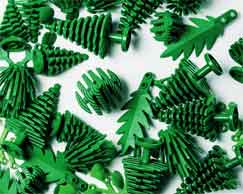The GreenSupplyChain.com has reported several times in recent years on Lego’s challenging quest to develop a more eco-friendly material to make its iconic building block toys in place of the oil-based plastics used today.
In 2015, Lego estimated the R&D will take some 15 years and lots of money. To find a plant-based material that would match the performance, consistency and feel of the traditional blocks since 1963. It has a goal to replace all petroleum-based plastics in its bricks with recycled or plant-based materials by 2030
"The ultimate prize would be for us not to notice one brick from the other," Tim Guy Brooks, then senior director of environmental sustainability at Lego said at the time, meaning a comparison between current bricks and those non-plastic versions in the future.
But Lego tolerances are very tight, at four thousandths of a millimeter, something ABS plastic can handle well. Plant-based plastics - not so much.
Lego tried making pieces from corn, but they were too soft. Its wheat-based bricks didn’t absorb color evenly or have the requisite shine. Bricks made from other materials proved too hard to pull apart, broke or had what executives call “creep,” when bricks lose their grip and collapse.
Some materials proved problematic to mold with Lego’s existing machinery. Recycled plastic is an option, but Lego needs large food-grade volumes – since kids often put the blocks in their mouths - with guarantees on quality.
Trying to solve the problem has led Lego to test more than 200 combinations of materials thus far.
 Lately, however, there has been some modest success. A material made from sugarcane-based bio polyethylene (Bio-PE) is now used in 2% of all Lego pieces, but primarily softer pieces like foliage, dragon wings and fishing rods. Lately, however, there has been some modest success. A material made from sugarcane-based bio polyethylene (Bio-PE) is now used in 2% of all Lego pieces, but primarily softer pieces like foliage, dragon wings and fishing rods.
Many other companies are similarly interested in plant-based plastics. For its part, Lego is sharing its findings with other companies – in effect, doing the research for the benefit of other companies (and the environment).
Nelleke van der Puil, Legos’s vice president for materials, recently answered a short series of questions with writer Anjali Khosla in a recent issue of United Airline’s Hemispheres magazine.
In Lego’s view, what qualifies as a sustainable material?
There’s no one real definition, but as we see it, it is a material from a source that is renewable. It can be a plant or a tree, or it can be an existing, used plastic that in principle could be converted to new plastic that is safe. The production of the plastic should not generate more CO2 than with the plastics of today.
How do you test new prospective materials?
We have a good network with universities, where we can look at the basic properties of materials, like durability. In our labs, we test candidate materials for functionality and play [value]. Is it sturdy enough? Does it clutch after so many months? Does it hold color in the right way? How does it behave in the molding process? Then we look at what is the best way to produce these materials.
Kids are liable to put toys in their mouths - so apparently one thing you test is how materials react to saliva?
We expose [materials] to a mixture of chemicals that comes close to representing saliva composition. It’s not that somebody’s drooling over it.
What knowledge do these experiments lead to?
If you look at what we’ve done with the Bio-PE, we’ve created interesting new sets with a very good story about sustainability. The treehouse that we just launched inspires our designers to work with materials and make that link to sustainability and make people more aware.
How far are you from finding an alternative material for Lego bricks?
We announced that by 2030 we would use sustainable materials in [all] our products. I think we’re still on track to get there. On the other hand, we see this as an adaptive challenge—there might be other options that might turn out to be more attractive at a later point. We keep our eyes open to new things that are developing in the plastics industry.
How does looking for sustainable materials benefit Lego’s bottom line?
If I look at it from the engineering perspective, we learn a lot about what we’re doing in production and how materials interact with the production environment. I think that is actually helping us to create new and exciting products in a more efficient way. So we grow our knowledge base.
Will Lego meet its 2030 goal? There are no guarantees, but if Lego falls short it won’t be for lack of effort.
What do you think of Lego’s quest? Let us know your thoughts at the Feedback button below.

|